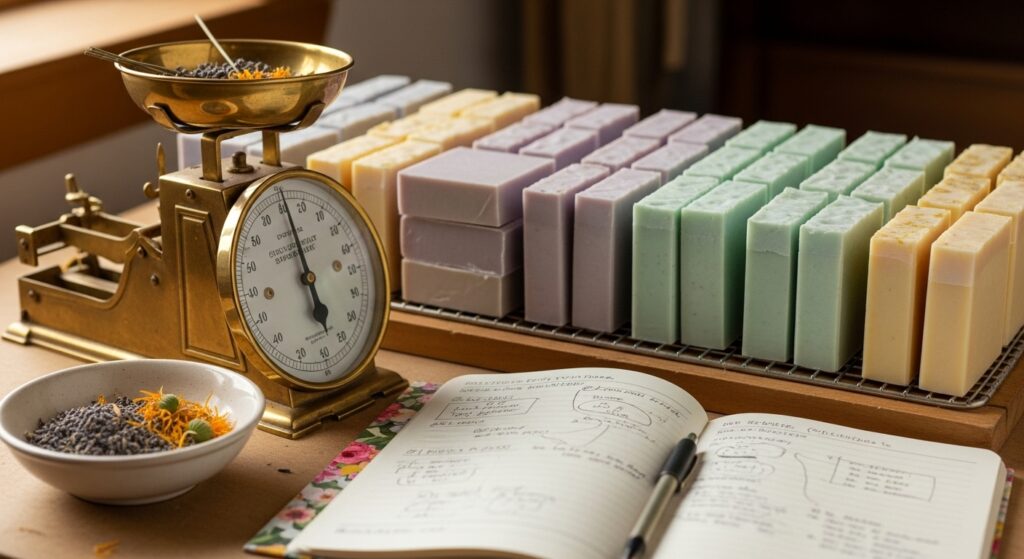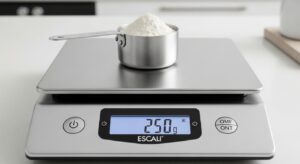Why a Good Scale Matters in Soap Making

When it comes to soap making, accuracy is everything. Even the most beautiful recipe can fail if your ingredients aren’t measured correctly. A good digital scale ensures your lye and oils are perfectly balanced, giving you safe, consistent, and high-quality soap every time.
Soap making is a science — and every gram counts. A dependable scale helps prevent lye-heavy batches, soft or oily bars, and wasted ingredients. Whether you make a few bars for fun or dozens for your soap business, a reliable scale is essential.
What to Look for in a Soap Making Scale
Choosing the right scale doesn’t need to be confusing. Here are the most important features to consider before you buy:
-
Multiple Units of Measure – Look for a scale that can read grams, ounces, and pounds. You’ll often use a mix of all three.
-
Accuracy – For soap making, choose one that measures to 1 gram or less for precision.
-
Capacity – A minimum of 11 pounds (5 kg) is ideal for medium-sized batches.
-
Surface Size – Make sure the platform is large enough for bowls or pots.
-
Digital Display – A clear, backlit screen makes reading easy.
-
Power Options – Models that run on both battery and AC power are most versatile.
-
Easy to Clean – Stainless steel or tempered glass platforms resist staining from oils and lye.
How to Use a Digital Scale Correctly
Even the best scale can mislead you if not used properly. Here are a few expert tips to keep your measurements accurate:
-
Tare (zero out) your container before adding ingredients.
-
Keep your scale level — an uneven surface affects accuracy.
-
Avoid fans, vibrations, or breezes that cause numbers to fluctuate.
-
Clean your scale after each use to prevent oil build-up or residue.
-
Check calibration and batteries regularly to ensure reliable readings.
🥣 Recommended Scales for Soap Makers
Below are a few scales I’ve used and personally recommend. Each one offers accurate readings, easy cleaning, and features that suit both hobbyists and professional soap makers.
🧡 Cuisinart KML-KO3B Precision Chef Bowl Electronic Kitchen Scale

This scale is a fantastic choice if you prefer a model with a built-in stainless-steel bowl. It holds up to 11 pounds, provides gram, ounce, and pound readings, and is sturdy enough for everyday use. The removable bowl is great for measuring oils, and cleanup is quick.
Affiliate Link Placeholder:
👉 Buy the Cuisinart Precision Chef Bowl Scale on Amazon
⚖️ Escali 136DK Alimento Stainless Steel Digital Scale

I’ve been using this scale for over 16 years — and it’s still going strong! It’s durable, extremely accurate, and simple to operate. I use it for everything: soap, lotions, balms, bath salts, and body butters.
Even small ingredient differences, like 1.1 vs. 1.2 ounces of beeswax, can change a lotion’s texture — and this scale handles that level of precision perfectly.
Affiliate Link Placeholder:
👉 Buy the Escali Alimento Digital Scale on Amazon
💚 Accuweight 207 Digital Kitchen Scale
If you’re looking for a budget-friendly option, this one’s ideal. It features a tempered glass top, a large back-lit display, and 1-gram accuracy. It’s sleek, compact, and great for small soap batches or home use.
Affiliate Link Placeholder:
👉 View the Accuweight 207 Kitchen Scale on Amazon
🖤 OXO Good Grips 5-Pound Food Scale
This compact digital scale is lightweight and easy to store. It’s perfect for smaller projects like weighing colorants, essential oils, or test batches. The pull-out display keeps readings visible even when using large bowls.
Affiliate Link Placeholder:
👉 Shop the OXO Good Grips Food Scale on Amazon
💪 Homever 15kg Digital Kitchen Scale
For soap makers producing larger batches, this is a powerful option. With a capacity up to 15 kg (33 lbs) and 1g accuracy, it’s ideal for bulk production or heavier molds.
Affiliate Link Placeholder:
👉 Check out the Homever 15kg Scale on Amazon
Pro Tips for Consistent Soap Making Measurements
-
Stick to one measurement system. Grams are often the most consistent across recipes.
-
Weigh everything. Avoid measuring liquids by volume — always use weight for accuracy.
-
Use the same container for lye and water each time to keep your ratios steady.
-
Record your results and adjust only in small increments between batches.
If you make other bath and body products like lotions or balms, precision becomes even more important.
A difference of just 0.1 ounce can turn a soft cream into a hard balm — so a good scale pays for itself quickly.
Caring for Your Soap Making Scale
Your scale will serve you for years if you treat it well:
-
Wipe it clean with a soft, damp cloth after each session.
-
Avoid getting water or oils inside the buttons.
-
Store in a dry, stable place to protect the sensors.
-
Replace batteries annually or as soon as the display dims.
Mine has lasted more than a decade with regular use — proof that quality equipment really does make a difference.
Final Thoughts
No matter your skill level, a dependable scale is a must-have tool for any soap maker. It keeps your recipes safe, your bars consistent, and your process professional.
Whether you’re crafting a few bars for yourself or making hundreds for customers, choose a scale that offers accuracy, durability, and versatility. Once you do, you’ll wonder how you ever made soap without it!
© 2025, Tes. All rights reserved.

Great point. A scale would definitely be necessary in the art of soap making. It is like baking, as if you don’t measure the ingredients properly you will end up with a disaster.
Is the scale pictured on the right suitable for large scale soap production or should one go even bigger?
The Scale on the right will hold up to 11 lbs. that amount of oils will make approximately 75 bars of soap. I find 11 lbs is heavy enough for lifting and pouring, but you could certainly use this scale for bigger batches, just by measuring out your oils in two or more measurings and adding to another pot. Either that or getting a bigger scale, but unless you have something to help with the pouring, I’d stick to the smaller batches.
I never realized how important a scale was for making soap. We did that growing up a few times, and always ended up mismatch of quality. But you’re right, having a great scale would matter, especially for the ingredients. From your review, it seems like having the stainless steal would be a better decisions. It would be easier to wash.
I do find the stainless steel scale easy to clean, so yes that’s the one I use.